| |||||
| Decades: | |||||
|---|---|---|---|---|---|
| See also: | Other events of 1930 Years in Iran | ||||
The following lists events that have happened in 1930 in Iran.
| |||||
| Decades: | |||||
|---|---|---|---|---|---|
| See also: | Other events of 1930 Years in Iran | ||||
The following lists events that have happened in 1930 in Iran.

Reza Shah Pahlavi was an Iranian military officer and the founder of the Pahlavi dynasty. As a politician, he previously served as minister of war and prime minister of Qajar Iran and subsequently reigned as Shah of Pahlavi Iran from 1925 until he was forced to abdicate after the Anglo-Soviet invasion of Iran in 1941. He was succeeded by his eldest son, Mohammad Reza Shah. A modernizer, Reza Shah clashed with the Shia clergy and introduced many social, economic, and political reforms during his reign, ultimately laying the foundation of the modern Iranian state. As a result, he is regarded by many as the founder of modern Iran.
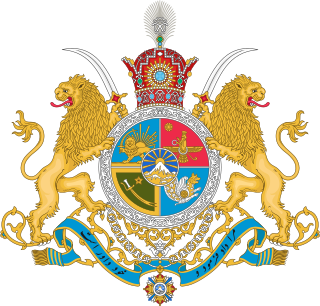
The Pahlavi dynasty was the last Iranian royal dynasty that ruled for a little over 53 years between 1925 and 1979. The dynasty was founded by Reza Shah Pahlavi, a non-aristocratic Mazanderani soldier in modern times, who took on the name of the Pahlavi language spoken in the pre-Islamic Sasanian Empire to strengthen his nationalist credentials.

The Qajar dynasty was an Iranian royal dynasty founded by Mohammad Khan of the Qoyunlu clan of the Turkoman Qajar tribe.
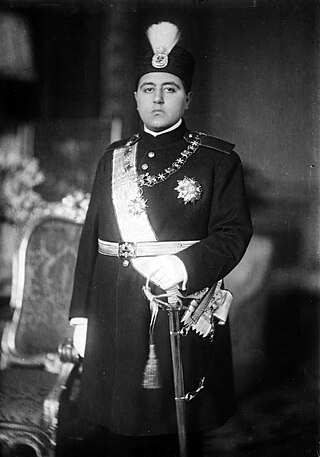
Ahmad Shah Qajar was the Shah of Persia (Iran) from 16 July 1909 to 15 December 1925, and the last ruling member of the Qajar dynasty.

Mohammad Ali Shah Qajar was the sixth shah of the Qajar dynasty and remained the Shah of Iran from 8 January 1907 until being deposed on 16 July 1909.
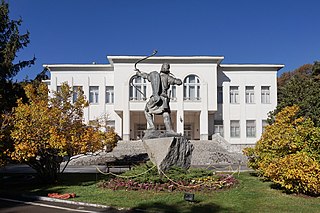
The Sa'dabad Complex is a 80 hectare complex built by the Qajar and Pahlavi monarchs, located in Shemiran, Greater Tehran, Iran. Today, the official residence of the President of Iran is located adjacent to the complex.

Mohammad Hassan Mirza Qajar was a younger brother of the last Qajar Shah of Iran Ahmad Shah Qajar, and former Crown Prince of the Qajar dynasty. Soon after Reza Shah deposed the Qajar dynasty and installed himself as Shah of Iran in 1925, Mohammad Hassan and his family were sent into permanent exile to England. In 1930, he declared himself the rightful heir to the crown as pretender to the throne. He died on 7 January 1943 in Maidenhead, England and was buried in Kerbala, Iraq.

The Shrine of Fatima Masumeh is located in Qom, which is considered by Twelver Shia Muslims to be the second most sacred city in Iran after Mashhad.

Shah Cheragh is a 12th century funerary monument and religious complex located in Shiraz, Iran. It is centred around the mausoleum of Sayyid Ahmad, the son of Musa al-Kazim, who is known as Shah Cheragh in local traditions, and hence the building is named as such. The site is the 363rd national monument of Iran.
Ahmed Shah or Ahmad Shah is the name of:
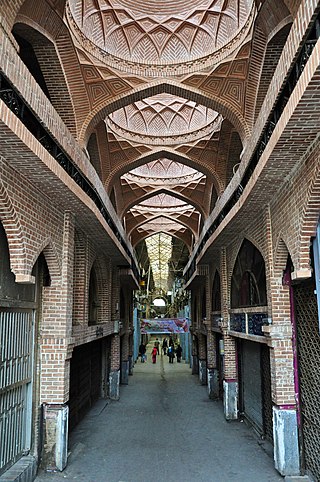
Tehran has grown dramatically since Mohammad Khan Qajar chose it as the capital of the Qajar dynasty in 1796. Despite the occurrence of earthquakes during the Qajar period and before, some buildings still remain from Tehran's era of antiquity. However, most of Tehran's historic architecture has been obliterated by the wave of hasty modernization that swept through the capital over the last 40 to 50 years. Of the eight city gates of old Tehran, none remain today. The Qajar culture flowered into a mature form of vernacular architecture, and many relics today remain of this tradition. Most, however, are government offices and residences of the royal elite. The "Kushak" of Ahmad Shah in the Niavaran Palace Complex is an example of this tradition.

Yeprem Khan, born Yeprem Davidyan, was an Iranian-Armenian member of the Armenian Revolutionary Federation (ARF), revolutionary leader and a leading figure in the Constitutional Revolution of Iran.

Kamran Mirza was a Persian Prince of Qajar dynasty and third surviving son of Nasser al-Din Shah. He was the brother of Mass'oud Mirza Zell-e Soltan and Mozzafar al-Din Shah. Kamran Mirza also served as Iran's Commander-in-Chief, appointed in 1868 for the first time, and minister of war from 1880 to 1896 and from 1906 to 1907.
1921 Persian coup d'état, known in Iran as 3 Esfand 1299 coup d'état, refers to several major events in Qajar Persia in 1921, which eventually led to the deposition of the Qajar dynasty and the establishment of the Pahlavi Empire as the ruling house of the country in 1925.

The Guarded Domains of Iran, commonly called Qajar Iran, Qajar Persia or the Qajar Empire, was the Iranian state under the rule of the Qajar dynasty, which was of Turkic origin, specifically from the Qajar tribe, from 1789 to 1925. The Qajar family took full control of Iran in 1794, deposing Lotf 'Ali Khan, the last Shah of the Zand dynasty, and re-asserted Iranian sovereignty over large parts of the Caucasus. In 1796, Agha Mohammad Khan Qajar seized Mashhad with ease, putting an end to the Afsharid dynasty. He was formally crowned as Shah after his punitive campaign against Iran's Georgian subjects.
The following lists events that have happened in 1907 in the Qajar dynasty.
The following lists events that have happened in 1908 in the Qajar dynasty in Iran.
The following lists events that have happened in 1909 in the Qajar dynasty, Iran.

Abu’l-Qāsem Khān Qarāgozlu, known by the title Nāṣer-al-molk, was an Iranian politician who served as Regent, Prime and Finance Minister of Iran during the Qajar dynasty.
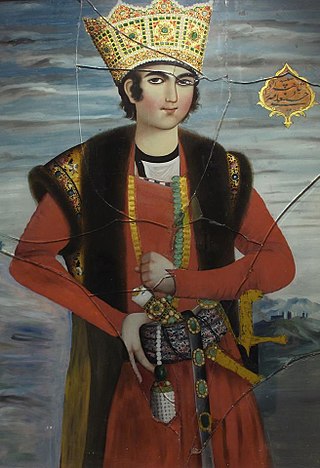
Hossein Ali Mirza, a son of Fath-Ali Shah, was the Governor of Fars and pretender to the throne of Qajar Iran.